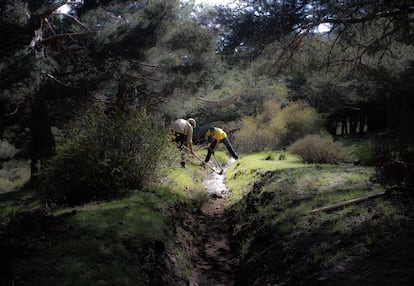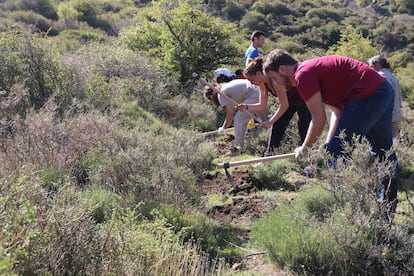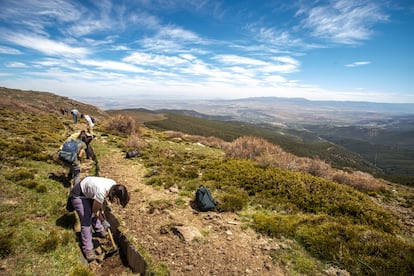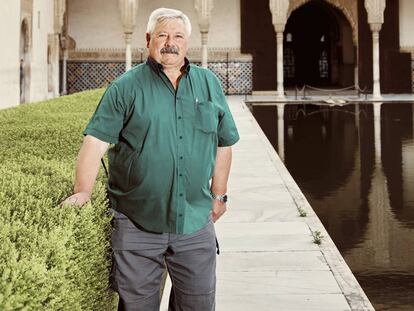Restoring water channels from the days of Al-Andalus to irrigate modern Spain
Thousands of kilometers of ‘acequias’ dug during the Islamic period were abandoned in the 20th century. A project by Granada University aims to put them back into use to help rural communities and support sustainable agriculture

Overlooking the city of Granada, in the upper reaches of Monte del Sombrero, the medieval historian and archeologist José María Civantos points out a ditch about five meters wide and two meters deep, filled with weeds and garbage.
“This is the Aynadamar acequia [irrigation channel],” he explains. “There are documents showing that for a thousand years it provided the Albaicín district of Granada with water, beginning in the 11th century. It supplied the artisans who went to the Alhambra to build the Nasrid palaces in the 13th and 14th centuries, and also the Catholic Monarchs’ troops who conquered the Nasrid kingdom in 1492.”
The channel climbs for about seven kilometers, crossing the ravine of Víznar, where the poet Federico García Lorca was executed in 1936, to its source at the Fuente Grande de Alfacar.
The Aydanamar acequia fell into disuse in the 1980s, after more than 1,000 years, when the construction of the road from Granada to Murcia cut across parts of it. But in the first quarter of 2022 it will once again be operative thanks to a project launched by the University of Granada, and developed by the MEMOLab laboratory, with funding from the Granada Water Foundation and the companies EMASAGRA and Hidralia.
“We will remove the waste that has been accumulating there, link the separated sections of the channel and allow the water to flow to the University of Granada campus to irrigate its gardens,” says Civantos.
But the Aydanamar watercourse is only a small part of the vast irrigation system that the Arabs built during their seven-century rule of much of the Iberian peninsula. The acequias were abandoned from the 1960s onwards as rural Spain became increasingly depopulated and the agri-food industry turned to an intensive model of farming, using irrigation systems incompatible with traditional methods.

To reverse the situation, the University of Granada launched a program for the recovery and cleaning of irrigation channels in 2014 that kicked off in the town of Cañar, in Granada’s Alpujarras mountain region, where a small community of about 200 residents had begun to reactivate the system. “The university provided resources and groups of volunteers and the irrigation community housed them in a local farmhouse and lent them materials,” says Cayetano Álvarez, president of the Cañar irrigation community whose two-hectare garlic and beans farm was one of the many that benefited from the water. “Over the course of a month, students and volunteers cleaned the Barjas irrigation channel. When the water began to flow along it for the first time in 30 years, we held a party – the water festival – which we have repeated every March since.”
The irrigation channel has not only provided locals with water, it has also strengthened social ties since its upkeep requires the collaboration of the entire community. “We have an acequiero who makes sure that leaves do not enter the channel where it flows through the oak groves. Otherwise, we keep it clean ourselves and share the water rights, not only in Cañas but with other towns like Órgiva, which also benefit,” says Álvarez. In 2015, a year after its implementation, the Barjas irrigation channel received recognition for good practices by the Hispania Nostra association.

“Since then, we have collaborated in the recovery of 14 abandoned irrigation channels and we have participated in the annual cleaning of at least another 30,” says Civantos, who promotes traditional agricultural methods combined with the latest technology, as well as the use of social media to organize volunteers. “This has meant working on more than 80 kilometers of acequias and the participation of some 1,500 people.” Despite efforts so far, the pending challenge is daunting as there are around 3,000 kilometers of irrigation channels in the Sierra Nevada alone, although Civantos estimates that in the provinces of Granada and Almeria there are around 24,000 acequias.
“But it is not only a question of volunteering and resources,” Civantos adds. “It is also about the social recognition of rural areas, agricultural activity and local knowledge, which is scientifically valid in most cases, all of which generates landscapes with cultural and environmental value – immense resources that are key to guaranteeing our future as a species.”
An economic revolution
In the year 711 AD, after a dazzling military campaign that ended with the destruction of the Visigothic kingdom and the conquest of the Iberian Peninsula, the Muslim invaders exchanged their swords and spears for picks and shovels and began to dig irrigation channels, taking advantage of the slopes on the land and using sticks and stones to build dams along the rivers, as they had seen their ancestors do in Syria and Arabia. “Irrigation and water management were essential for the economic development of Al-Andalus,” says Civantos. “This is the only way to explain the splendor of the Umayyads dynasty and the Córdoba Caliphate.”
Although the Iberian Peninsula already had very sophisticated irrigation systems, such as the Roman aqueducts, the Arabs placed irrigation at the heart of production. The irrigation channels, the drainage systems and the dams not only made it possible to adapt new tropical crops to the Mediterranean climate, such as citrus fruits, sugar cane, cotton, rice, artichoke and spinach, they also facilitated diversification and increased productivity, generating an essential surplus for the development of industry and trade in cities like Almeria and Granada.
“A clear example is the cultivation of mulberry trees and the silkworm, which was bred by the peasant women, giving rise to a flourishing economic activity and the export of thread and fabrics from enclaves such as Almeria to the entire Mediterranean and Europe,” says Civantos. The definitive expulsion of the Moriscos, former Muslims forced to convert to Christianity, at the end of the 16th and beginning of the 17th century put an abrupt end to this economic model.
Tu suscripción se está usando en otro dispositivo
¿Quieres añadir otro usuario a tu suscripción?
Si continúas leyendo en este dispositivo, no se podrá leer en el otro.
FlechaTu suscripción se está usando en otro dispositivo y solo puedes acceder a EL PAÍS desde un dispositivo a la vez.
Si quieres compartir tu cuenta, cambia tu suscripción a la modalidad Premium, así podrás añadir otro usuario. Cada uno accederá con su propia cuenta de email, lo que os permitirá personalizar vuestra experiencia en EL PAÍS.
¿Tienes una suscripción de empresa? Accede aquí para contratar más cuentas.
En el caso de no saber quién está usando tu cuenta, te recomendamos cambiar tu contraseña aquí.
Si decides continuar compartiendo tu cuenta, este mensaje se mostrará en tu dispositivo y en el de la otra persona que está usando tu cuenta de forma indefinida, afectando a tu experiencia de lectura. Puedes consultar aquí los términos y condiciones de la suscripción digital.
More information
Últimas noticias
Welcome to the post-religion era: The idea of Christianity as the absolute truth has become obsolete
‘I thought you would like it’: The risky sexual practice popularized by TV shows and TikTok
The digitalization of tourism: ‘They promise experiences and gave us the worst possible one’
Mexican peso defies uncertainty with forecasts of a new period of stability in 2026
Most viewed
- Sinaloa Cartel war is taking its toll on Los Chapitos
- Reinhard Genzel, Nobel laureate in physics: ‘One-minute videos will never give you the truth’
- Oona Chaplin: ‘I told James Cameron that I was living in a treehouse and starting a permaculture project with a friend’
- Why the price of coffee has skyrocketed: from Brazilian plantations to specialty coffee houses
- Silver prices are going crazy: This is what’s fueling the rally










































